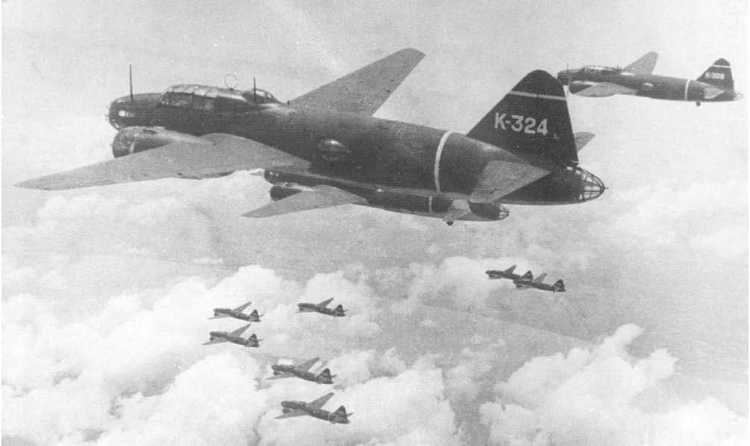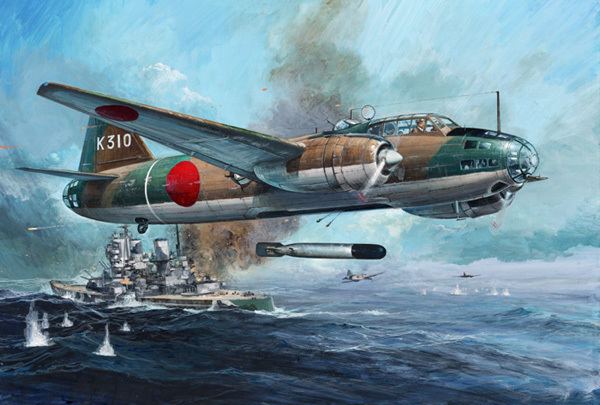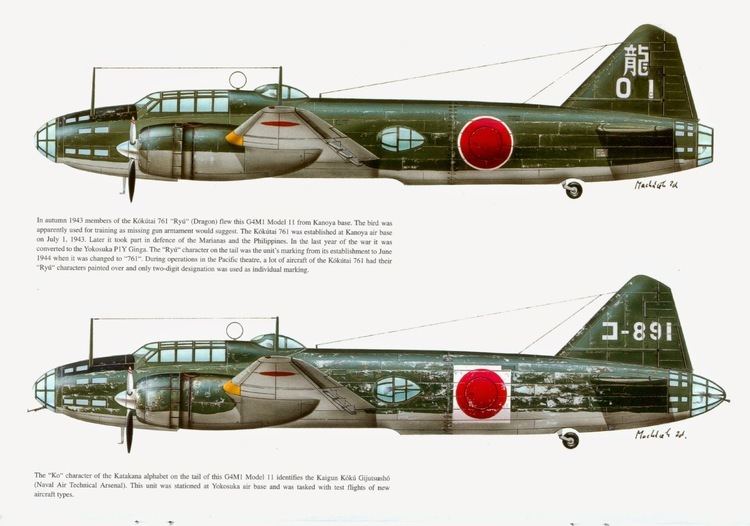Length 20 m Introduced June 1941 | Wingspan 25 m Retired 1945 First flight October 23, 1939 | |
 | ||
Manufacturers | ||
Mitsubishi g4m crash giant rc model plane
The Mitsubishi G4M (long designation: Mitsubishi Navy Type 1 attack bomber: 一式陸上攻撃機, 一式陸攻 Isshiki rikujō kōgeki ki, Isshikirikkō) was the main twin-engine, land-based bomber used by the Imperial Japanese Navy Air Service in World War II. The Allies gave the G4M the reporting name Betty. Japanese Navy pilots called it Hamaki (葉巻, "cigar", lit. "leaf roll") due to its cylindrical shape.
Contents
- Mitsubishi g4m crash giant rc model plane
- 2011 geneseo fac non nats mitsubishi g4m betty flight
- Design and development
- Production
- Operational history
- G4M1
- G4M2
- G4M3
- G6M1
- Operators
- Postwar
- Surviving aircraft
- Specifications G4M1 Model 11
- References

The G4M had very good performance, especially range, which was achieved by its structural lightness and an almost total lack of protection for its crew, with no armor plating or self-sealing fuel tanks. These omissions proved to be its weakness when confronted with American fighter aircraft during the Pacific War.

2011 geneseo fac non nats mitsubishi g4m betty flight
Design and development

The G4M was designed for a long range and high speed at the time of its introduction. Consequently, several weight-saving measures were incorporated into the design, such as dispensing with self-sealing fuel tanks and armor, which caused Allied fighter pilots to give it derisive nicknames such as "the one-shot lighter", "the flying Zippo" and "the flying cigar" because of their tendency to explode or catch on fire from any slight damage to the wing fuel tanks after being hit by aerial machine gun fire or ground-based anti-aircraft fire. Similarly, pilots of the Imperial Japanese Navy despairingly called the G4M the "type one lighter", the "flying lighter" and the "hamaki" ("cigar"). This was partially due to the fact that on many occasions, the G4M was used for low-altitude torpedo attacks on ships during which their performance advantages were negated. The G4M was frequently shot down by anti-aircraft artillery fire, and even by small arms. The G4M's relatively large size made it an easy gunnery target, and the predictable approach path required for a torpedo run made for a generally easy interception by Allied fighter aircraft.

When used for medium- to high-altitude bombing against stationary land targets like supply depots, seaports or airfields, it was much harder to intercept. Using its long range and high speed, the G4M could appear from any direction, and then it could be gone before any fighters intercepted them. The 20 mm cannon in its tail turret was much heavier armament than was commonly carried by bombers of either side, making aerial attacks from the rear quite dangerous for the Allied fighter aircraft. Sometimes, assuming they did not catch fire after being hit in the wings by flak from the ground or by machine gun bullets from enemy fighters, G4Ms also proved to be able to remain airborne despite being badly damaged. For example, after the attack of the 751 Kōkūtai (air group) on the USS Chicago (CA-29) during the Battle of Rennell Island, three out of four surviving aircraft (of the original eleven) returned despite flying with only one engine.
Production

Operational history
The G4M was similar in performance and missions to other contemporary twin-engine bombers such as the German Heinkel He 111 and the American North American B-25 Mitchell. These were all commonly used in anti-ship roles. The G4M Model 11 was prominent in attacks on Allied shipping from 1941 to early 1944, but after that it became increasingly easy prey for Allied fighters.
The G4M's baptism of fire occurred on 13 September 1940 in Mainland China, when 27 "Bettys" and Mitsubishi C5Ms of 1st Rengo Kōkūtai (a mixed force including elements of the Kanoya and Kizarazu Kōkūtai) departedfrom Taipei, Omura, and Jeju City to attack Hankow. The bombers and the reconnaissance aircraft were escorted by 13 A6M Zeros of 12th Kōkūtai led by the IJN lieutenant, Saburo Shindo. A similar operation occurred in May 1941. In December 1941, 107 G4Ms based on Formosa of 1st Kōkūtai and Kanoya Kōkūtai belonging to the 21st Koku Sentai (air flotilla) crossed the Luzon Strait en route to bombing the Philippines; this was the beginning of Japanese invasions in the Southwest Pacific Theater.
The G4M's most notable use as a torpedo bomber was in the sinking of Prince of Wales and Repulse off the eastern coast of Malaya on 10 December 1941. The G4Ms attacked along with older Mitsubishi G3M "Nell" bombers, which made high-level bombing runs. Prince of Wales and Repulse were the first two capital ships to be sunk exclusively by air attacks during a war, while in open waters. The bomber crews were from the Kanoya Air Group of Kanoya Kōkūtai (751 Ku), Genzan Air Group of Genzan Kōkūtai (753 Ku), and the Mihoro Air Group of Mihoro Kōkūtai (701 Ku), trained in torpedo attacks at an altitude of less than 10 metres (30 ft), and in long-range over-ocean navigation, so they could attack naval targets moving quickly at sea. Nine G4Ms participated in the long range bombing raid of Katherine, Northern Territory, on 22 March 1942 (the deepest inland attack on Australian territory during the war at over 200 miles from the coast). G4Ms later made many attacks against Allied ships and also land targets during the six-month-long Guadalcanal Campaign (in the Solomon Islands) in late 1942.
On 8 August 1942, during the second day of the U.S. Marine landings on Guadalcanal, 23 IJNAF torpedo-carrying G4M1s attacked American ships at Lunga Point. 18 of the G4M1s were shot down, by very heavy anti-aircraft fire and carrier-based F4F fighters. In all 18 Japanese crews – approximately 120 aviators – were lost at the beginning of August 1942. More than 100 G4M1s and their pilots and crews were lost (with no replacements or substitutes available) during the many battles over and near Guadalcanal (August to October 1942). In the two days of the Battle of Rennell Island, 29 and 30 January 1943, 10 out of 43 G4M1s were shot down during night torpedo attacks, all by U.S. Navy anti-aircraft fire. About 70 Japanese aviators, including Lieutenant Commander Higai, were killed during that battle.
Probably the best-known incident involving a G4M during the war was the attack resulting in the death of Admiral Yamamoto. On 18 April 1943, P-38s of the 339th Fighter Squadron of the 347th Fighter Group, Thirteenth Air Force, shot down G4M T1-323, carrying Admiral Yamamoto.
The G4M Model 11 was replaced by the Models 22, 22a/b, 24a/b, 25, 26, and 27 from June 1943 onward, giving service in New Guinea, the Solomons, and the South Pacific area, in defense of the Marianas and finally in Okinawa. Other G4Ms received field modifications, resulting in the Model 24j This model carried the Yokosuka MXY7 Ohka Model 11 suicide flying bomb, beginning on 21 March 1945, with disastrous results due to heavy Allied fighter opposition.
After the loss of Okinawa, G4Ms constituted the main weapon of the land-based Japanese naval bomber force. It consisted of 20 Kōkūtai at the end of the war. This included the testing air group, which was equipped in 1944–45 with the latest version G4M3 Models 34 and 36, though these arrived too late to affect the course of the war.
From November 1944 to January 1945, G4Ms were one of the main types of aircraft used in the Japanese air attacks on the Mariana Islands, and plans to use converted G4Ms to land commandos on the islands were developed in mid-1945 and cancelled only at the end of the war.
As part of the negotiations for the surrender of Japan, two demilitarized G4Ms, given the call-signs Bataan 1 and Bataan 2, flew to Ie Shima, carrying the first surrender delegations on the first leg of their flight to Manila. The G4Ms were painted white with green crosses, and were escorted by American P-38 fighters.
The G4M's intended successor was the Yokosuka P1Y Ginga, although because of production problems, the changeover was only begun by the time the war ended.
G4M1
Production of the G4M1 ended in January 1944.
G4M2
The first of the four G4M2 prototypes flew in December 1942 (Mitsubishi Navy Type 1 Attack Bomber Model 22). It differed from the preceding model in having Mitsubishi MK4P "Kasei" Model 21 engines with VDM electric four-blade propellers capable of full feathering function, redesigned main wings with LB type laminar flow airfoil. and widened tail horizontal stabilizer wing area, which improved service ceiling to 8,950 m (29,360 ft) and maximum speed to 437 km/h (236 kn; 272 mph). Main wing fuel tanks were enlarged to 6,490 l (1,710 US gal; 1,430 imp gal) which increased the range to 6,000 km (3,200 nmi; 3,700 mi) (overloaded, one way). An electrically powered dorsal turret featuring a 20 mm (0.787 in) Type 99 cannon was introduced in place of G4M1's dorsal position with a 7.7 mm (0.303 in) Type 92 machine gun, total guns armed were two 20 mm (0.787 in) Type 99 cannons (one tail turret, one top turret), and four 7.7 mm (0.303 in) Type 92 machine guns (one nose, two waist, and one cockpit side). External differences also included increased nose glazing, flush side gun positions instead of blisters, and rounded tips of wings and tail surfaces. These major improvements also made it possible for the G4M2 to carry more powerful bombs; one 1,055 kg (2,326 lb) Navy Type 91 Kai-7 aerial torpedo or one 800 kg (1,800 lb) bomb or two 500 kg (1,100 lb) bombs or one 800 kg (1,800 lb) Type 3 No. 31 bomb (ray-detective type bomb) and twelve 60 kg (130 lb) bombs. The G4M2 entered service in mid-1943.
G4M3
G6M1
Operators
Postwar
Surviving aircraft
There are no flyable or intact Mitsubishi G4Ms left. Several wrecks remain scattered in southeast Asia and on Pacific islands, although only one complete aircraft is known to be on display. That example is a G4M1 Model 11, built in Nagoya Works No. 3 on 16 April 1942, tail number 370, which had likely crash landed before mid-1944, and was recovered from Babo Airfield, Indonesia, in 1991. The wreck is on display in a diorama at the Planes of Fame Air Museum. Several other locations display pieces of G4Ms. The restored fuselage of a G4M2 is on display at the Kawaguchiko Motor Museum in Yamanashi Prefecture, Japan.
Specifications (G4M1, Model 11)
Data from Airreview's Japanese Navy Aircraft in the Pacific War
General characteristics
Performance
Armament
